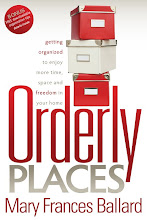Fall is officially here.
In some parts of our country the weather may not show it, but it is time
to get moving towards the season filled with decorating and entertaining.
Buy your Christmas Cards now while selection is best and
send out “Save the Date” cards for any holiday events you plan. Update your calendar with all the special
fall events taking place, put out your fall décor and get your yard ready for
falling leaves.
This month we will concentrate on getting the dining room
and/or eating areas organized and ready for holiday entertainment.
- If you have a dining room that is not used often, the table can become a dumping ground for items put there temporarily. What starts out as the mail mutates into miscellaneous things coming into the house. Start today to make it off limits for the temporary put down.
- Inventory your linens and purge what you haven’t used in years. If some hold sentimental value, see if someone in your family can use them and give them the honor they deserve. If some are in need of repair, make the decision to take care of that or to move them on. Remember removing those that you do not use will make more space for those that you love and use.
- Look over your dinnerware and remove pieces that cannot be used because of chips or other damage. If there are odd pieces that cannot be used with other items, move them out, too. Complete sets that are stored in boxes and never opened should be sold, donated or given to someone who wants them. As with your linens, move on pieces that are simply taking up space.
- Provide adequate seating for all those eating together. Folding chairs can be used and stored in a closet or other storage area afterwards. Wooden posts located on the wall of the garage can be used to hang them so they do not take up floor space.
- Cloth or paper napkins can be placed in an attractive basket, bowl or tray and serve as a centerpiece.
- Placemats are more versatile to use than tablecloths and can be left on the table as decorations or stacked in the center with a napkin basket.
- Dinnerware, flatware and serving pieces should be located in an area convenient to setting the table and replacing after clean up.
- Special occasion or seasonal dinnerware or silverware should be kept only if used and you have sufficient space for it. .
- Table cloths can be stored in shallow drawers or hung over a dowel or hanger covered with the empty roll from wrapping paper or paper towels. Slit the roll on one side and slip it over the rod. Hang it in a closet. This will prevent additional wrinkles.
- Additional linens can be stored in the drawers or shelves of dining room furniture such as chests or buffets. You may also use a linen closet if one exists.
- Consider placing a clothing chest with drawers in the dining room if no longer needed for clothing. It is ideal for linens.
Additional Activities to make the dining room more functional
- The dining table may be a good choice for homework if the room is good for studying. A tote with desk supplies may be used and then stored when the work is done.
- It may also used for craft projects or other art activities. Cover the table with a protective cloth, cutting board or plastic before using it. Portable storage for those supplies make it easier to clean the area when done.
- If the family needs home office space, reserving a corner of the dining room for that activity is a good use of space. Choose a table or desk that compliments the other furnishings. Some items can be stored in the furniture already there or in rolling carts and file trolleys that can be moved to a nearby closet when not in use.
- If there is not space in the family room for board games and card playing, those items could be stored in the dining room for use there..
- When not used, keep the tops of buffets, chests and china cabinets clear and free of clutter..
- Keep the table attractive when not used with a centerpiece and/or tablecloth.
- Use washable decorative fabrics on surfaces to reduce the amount of dusting.
The end of the month also brings Halloween
and the Trick or Treat invaders.
·
First you want to be sure the pathway to your
door is safe. Remember to clean the driveway, sidewalk, steps and porch while
it is still daylight. Fallen leaves can be slippery especially when w et so they should be removed as well as any toys,
twigs, etc. Make sure this area is well lit by leaving your porch light and any
other light fixtures on during the Trick or Treat hours.
·
It is recommended
that you give only individually pre-wrapped candy. Since this is the beginning
of flu season, you should not allow each child to reach into
your container to get the candy since each one could be contaminating the other
pieces with his hands. Rather, you should choose and drop the candy into each
child's bag yourself.
·
As an extra
precaution, you may want to use disinfecting wipes to clean your doorbell or
door handles if you keep it closed between visitors. This can be done
periodically during the evening or at the end when Trick or Treating is over. Keep
hand sanitizer near the door and use it yourself as often as you think
necessary. It is a shame we need to be
so careful, but it is always better to be safe than sorry and we want to do our
part in keeping our homes and neighbors as healthy and safe as possible.
If you have the splendor of seeing the leaves changing
colors in the fall, get out and enjoy it as much as you can. It is one of the most beautiful times of the
year.




